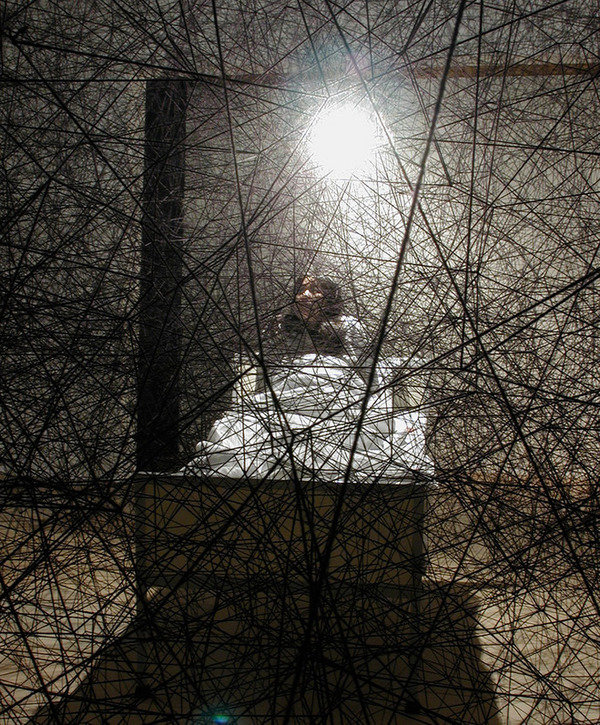Chiharu Shiota / Juliao Sarmento
dal 6/1/2012 al 17/2/2012
Segnalato da
6/1/2012
Chiharu Shiota / Juliao Sarmento
Galerie Daniel Templon, Paris
Infinity / Quelques Jeux Interdits. Infinity is a monumental installation designed especially for the gallery. The artist weaves vast structures in black wool thread that imprison various evocative objects, such as musical instruments, dolls' dresses, shoes and beds. These objects are floating and liberated from their primary purpose, conjuring up poetic and moving images for the viewer. They call forth memories and emphasise absences. Sarmento's works on canvas are subtle and enigmatic, exploring the terrain mapped out by desire and representation.

Chiharu Shiota
Infinity
In the wake of her widely noted exhibition at the Maison Rouge in spring 2011, artist Chiharu Shiota is returning to Paris to exhibit at Galerie Daniel Templon. She will be showing a monumental installation designed especially for the gallery’s Impasse Beaubourg space.
Chiharu Shiota combines performance, body art and installations in a process that places the body at the centre of her sculptural work. She studied with Marina Abramovic in Hamburg in the 1990s. Her artistic language was influenced by pioneering artists Louise Bourgeois, Eva Hesse and Ana Mendieta, both in terms of physical experimentation and the focus on the unconscious, and the choice of delicate materials like fabrics and thread, traditionally associated with femininity.
Chiharu Shiota began creating her series of installations made of tangled threads in 1996. The installations turn the work of art into an extension of her own absent body, mirroring a spider’s web.
The artist weaves vast structures in black wool thread that imprison various evocative objects, such as musical instruments, dolls’ dresses, shoes and beds.
These objects are floating and liberated from their primary purpose, conjuring up poetic and moving images for the viewer. They call forth memories and emphasise absences.
“I feel there is something common between the silence of the burnt piano and the silence on my way home, and that this is deeply hidden in my heart,”
Chiharu Shiota
The graphic network that connects the elements invokes the power of interpersonal bonds, the subject’s inevitable dependency on her or his roots, the very relationships that are harmed by the individualism of modern Western culture. “The threads are interwoven into each other. Get entangled. Are torn apart. And disentangle themselves. It is like a mirror of feeling,” writes Chiharu Shiota.
Born in the Japanese city of Osaka in 1972, Chiharu Shiota has been living and working in Berlin since 1997. She studied at the Berlin University of Fine Arts then the Hamburg University of Fine Arts and worked at Rebecca Horn’s studio.
Chiharu Shiota has performed and exhibited extensively, including at Brittany’s Domaine de Kerguéhennec in 1997, the Kunstmuseum in Bonn in 2000, Lille’s Eglise Sainte Madeline in 2004, Berlin’s Neue Nationalgalerie in 2006 and Osaka’s National Museum of Art in 2008. The artist took part in the most recent Venice Biennial, exhibiting the Memory of books installation at the Gervasuti Foundation. Chiharu Shiota also designed the set for Matsukaze, the Japanese opera directed by Sasha Waltz and performed in Brussels at the Théâtre royal de la Monnaie and in Berlin at the Staatsoper in 2011.
----
Juliao Sarmento
Quelques Jeux Interdits
Julião Sarmento, one of Portugal’s leading contemporary artists, is exhibiting at Galerie Templon for the first time.
His works on canvas are subtle and enigmatic, exploring the terrain mapped out by desire and representation.
Julião Sarmento combines fragments of photographs and texts with his graphic images executed in graphite. Human silhouettes, architectural images and words are subjected to the same process of obliteration, effected by means of a cinematographic approach to framing the subjects, an unfinished gesture or a thick layer of acrylic paint that swallows them up. The artist tells us that the subject is “that which is not there.” An open window on possible narratives and relationships, his painting invites the viewer to give free reign to her or his imagination and the voyeuristic pleasures of the partial glimpse.
Julião Sarmento’s careful focus on texture and materials also turns his works into an act of materiality.
The artist exploits a huge variety of combinations to create a series of works with recurring motifs: an archetypal woman with no face, modernist architectural images, plant-like lines and references to literature and the cinema. Bataille’s eroticism, Raymond Carver’s American stories and Fernando Pessoa’s “disquiet” all provide signposts to the dramas bubbling beneath the surface of Julião Sarmento’s art.
“It’s all about setting the tangible sensuality of skin against the domesticity of home, the fetishist power of a word against the propriety of an explication. Against the peacefulness of a finished image, promoting the interminable procession of image upon image,”
Alexandre Melo, art critic
Born in Lisbon in 1948, Julião Sarmento studied painting and architecture at the Lisbon School of Fine Arts. In the 1970s, he began to develop a method combining painting, video and sound and modelled installations. He has taken part in over a hundred exhibitions throughout the world. Julião Sarmento represented Portugal at the Venice Biennial in 1997. More recently, his work has featured at London’s Tate Modern, with a dedicated Artist Room, the Malaga Centro de Arte Contemporaneo in Spain (2010) and the Contemporary Art Center in Cincinnati (2011). The Fundaçao Serralves in Porto has scheduled a major retrospective on the artist for autumn 2012.
Julião Sarmento’s work is included in numerous major public collections, including at the Museum of Modern Art (MOMA) and Solomon Guggenheim Museum in New York, Musée national d’art moderne/Centre Pompidou in Paris and Moderna Museet in Stockholm.
Image: Chiharu Shiota, One Place, 2001 © Chiharu Shiota
Galerie Daniel Templon
30 rue Beabourg 75003 Paris
Hors: mon-sat 10-7pm



